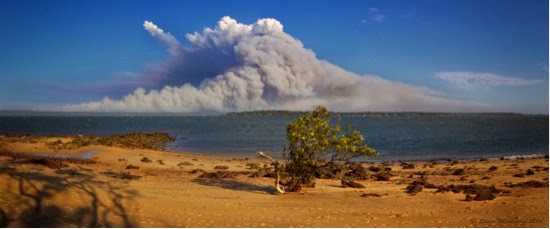Microplastic - a Developing Threat to Our Oceans
Scientific studies in Australian waters and in the seas around Britain have found that microplastic concentrations are increasing and showing evidence of effects on ocean ecosystems.
Australian scientists from the University of Western Australia set up ocean net stations to trap plastic fragments, siting these nets around most of the circumference of the continent and across to Fiji. Results have ascertained an average of 4256.4 pieces, at a median size of 2.8mm, per square kilometer with much higher concentrations contributing to this average coming from nets positioned around the populated areas of Sydney and Brisbane. Unfortunately these results put Stradbroke Island in a hot spot for plastic.
Studies undertaken by scientists from Plymouth and Exeter Universities, on the English south coast, involved investigating the effect of ingestion of microplastics on lugworms, an indicator species at the bottom of the food chain. An important food source for fish and seabirds, lugworms also act in a similar way to terrestrial earthworms by turning over and oxygenating the upper layers of sand to keep the sediment healthy for other sea creatures and microorganisms.
Sluggishness with less energy for feeding and reproduction were found to be among deleterious health effects on the worms by scientists from Exeter University. The study from Plymouth has established that ingesting microplastics transfers pollutants to the worms, clearly affecting their health. Plastic particles have a propensity to attract pollutants or are coated with them in the manufacturing process. Pollutants found include hydrocarbons, antimicrobials, flame-retardants and dyes.
Common materials found in the oceans, in “micro” form, are polyethylene, polyethylene terephthalate and PVC or polystyrene. Single use packaging is estimated to make up 80% of the plastic breaking down into smaller and smaller pieces. But other sources of microplastic include the raw material melted down for plastic manufacture, little balls called “nurdles”, also used for exfoliating beads in face and bodywash products and surprisingly fibres from synthetic textiles like polyester which apparently can release up to 2000 tiny fibres per garment each time they are washed.
So far, the emphasis on plastic control in the sea has been on the danger of larger plastic items like plastic bags and fishing line choking, obstructing and entangling birds, turtles and other sea life, but now the research is indicating that microplastic is having an impact at the base of the food chain, on the creatures that form an important link to keeping the ocean ecosystems healthy. These studies have opened the way for closer scrutiny of the problems we are creating by using enormous amounts of plastic in our everyday lives and the need for international regulation of plastic disposal on land and sea.
Studies undertaken by scientists from Plymouth and Exeter Universities, on the English south coast, involved investigating the effect of ingestion of microplastics on lugworms, an indicator species at the bottom of the food chain. An important food source for fish and seabirds, lugworms also act in a similar way to terrestrial earthworms by turning over and oxygenating the upper layers of sand to keep the sediment healthy for other sea creatures and microorganisms.
Sluggishness with less energy for feeding and reproduction were found to be among deleterious health effects on the worms by scientists from Exeter University. The study from Plymouth has established that ingesting microplastics transfers pollutants to the worms, clearly affecting their health. Plastic particles have a propensity to attract pollutants or are coated with them in the manufacturing process. Pollutants found include hydrocarbons, antimicrobials, flame-retardants and dyes.
Common materials found in the oceans, in “micro” form, are polyethylene, polyethylene terephthalate and PVC or polystyrene. Single use packaging is estimated to make up 80% of the plastic breaking down into smaller and smaller pieces. But other sources of microplastic include the raw material melted down for plastic manufacture, little balls called “nurdles”, also used for exfoliating beads in face and bodywash products and surprisingly fibres from synthetic textiles like polyester which apparently can release up to 2000 tiny fibres per garment each time they are washed.
So far, the emphasis on plastic control in the sea has been on the danger of larger plastic items like plastic bags and fishing line choking, obstructing and entangling birds, turtles and other sea life, but now the research is indicating that microplastic is having an impact at the base of the food chain, on the creatures that form an important link to keeping the ocean ecosystems healthy. These studies have opened the way for closer scrutiny of the problems we are creating by using enormous amounts of plastic in our everyday lives and the need for international regulation of plastic disposal on land and sea.


